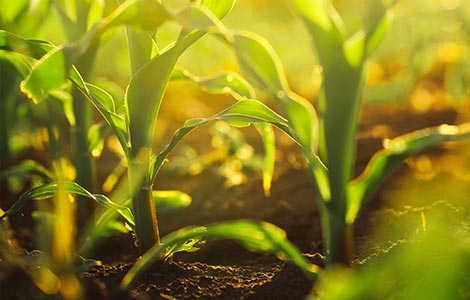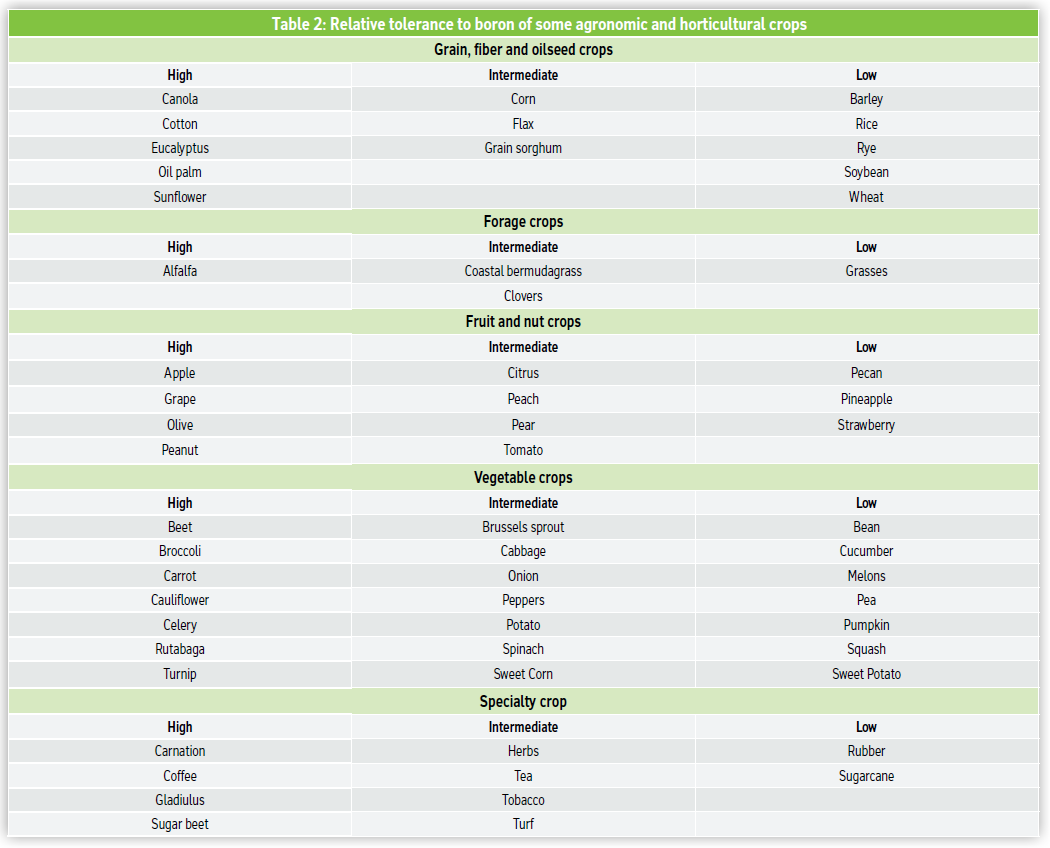
- Boron is essential for all plant growth. It aids in the transfer of sugars and nutrients from leaves to fruit, and increases pollination and seed development.
- Plant species vary considerably in their tolerance to the boron supply in the root environment.
- Plant species also vary considerably in their boron requirement.
- Reports show that many of those crops with higher boron requirements also usually have a greater tolerance to higher levels of available boron, so applying recommended boron rates and methods should not result in problems with excessive boron.
- Growers should know the relative boron needs for each specific crop, as well as the available boron supply in the soil to determine the optimum rate and method of applying sufficient boron for optimum yields.
Boron (B) was first shown to be an essential micronutrient for plant growth and development by Warington in 1923.
Results of numerous experiments since then have shown that the range in soil boron levels that may result in boron deficiencies or in possible toxicity symptoms is relatively narrow, compared with ranges of most other plant nutrients. This is because the levels of available boron in soils are low (generally < 2 ppm), but the amounts of boron to satisfy plant needs also are low. The recommended application rate of boron fertilizers usually ranges from 0-4 lbs of B/acre.
Boron nutrition is a special concern in crop production; growers want to ensure that the available boron supply is sufficient for optimum nutrition but not so high as to result in reduced yields from an over-supply.
Current evidence shows that many plant species can tolerate much higher rates of applied boron than previously thought.
Because boron toxicities in plants—resulting from naturally-occurring high levels of available boron in soils or an over-application rate of fertilizer boron—result in reduced growth and development, growers may be overly cautious in applying sufficient boron to assure optimum yields.
It is important to know the supply of available soil boron, the specific crop’s boron needs, and the intended method of boron application. Plant analyses are another useful tool in determining the general boron status of crops during the growing season.
Boron-sufficiency ranges of many agronomic and horticultural crops are listed in Agronomy Note: Boron Deficiency Symptoms.
Crops vary in boron tolerance
Plant uptake of boron is related primarily to the boron concentration of the soil solution in the root zone. Soluble boron is very mobile in soils and can be easily absorbed by plant roots.
Experiments to determine the relative tolerance of various species of plants have been conducted in sand cultures to reduce the number of factors (such as soil reactions) which affect the actual boron concentrations in the soil solution of the root zone.
Toxicities observed in some plant species, which may be ascribed to boron, may also be confounded with problems due to excessive salt accumulations in the soil, most of which may be ions other than the borate ion.
Therefore, it’s best to discuss plant tolerance to boron in relative categories (tolerant, moderately tolerant, moderately sensitive, and sensitive) rather than by the actual soluble boron concentrations in the root zone.
A list of the relative tolerance of some of the most common agronomic and horticultural crops is given in Table 1.

Crops vary in boron requirement
It is well known that agronomic and horticultural crops vary considerably in their boron requirement.
Growers should know if crops have high, intermediate, or low boron requirements.
Table 2 lists crops with high, intermediate and low boron requirements. It has been thought that legumes generally have higher boron requirements than grass crops (monocotyledons). In reality, there are considerable differences in boron requirements within each group. For example, alfalfa has a high boron requirement but dry beans and soybeans have much lower boron requirements. Crops with low boron requirements still require an adequate boron supply to produce optimum yields.
It is important to note that some of the main crops listed in the tolerant and semi-tolerant categories of Table 1 also are those listed in Table 2 with high boron requirements. Conversely, those crops in Table 1 that are sensitive to boron also are those with low boron requirements (in Table 2).
Because most of the crops fertilized with boron are those that have high boron requirements and also are tolerant of higher boron levels in the root zone, applying the recommended boron rates should not result in problems with excessive boron levels in plants.

Download Agronomy Notes